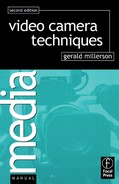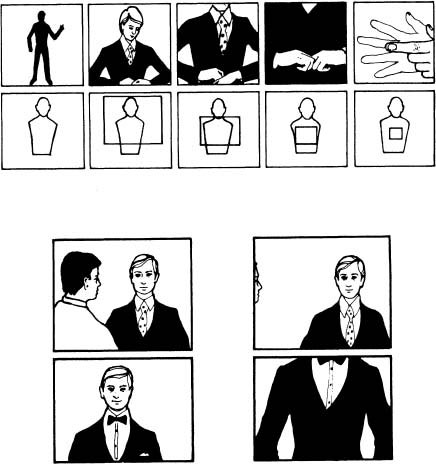Whether an experienced actor or a first-time guest, the person in front of the camera has a sense of isolation – a feeling that now it’s all up to them. Without taking on the role of a second director or bypassing the floor manager, the crew can help in various unobtrusive ways to put them at their ease. Even a regular professional’s performance can fall off when faced with the ‘cold turkey’ reception of an indifferent floor crew. A friendly grin can be infectious!
Many who appear in front of the camera are quite unfamiliar with television techniques, and are very willing to be told how they can help to get the best shots possible. Even an experienced demonstrator or interviewer may not realize that they are creating problems. That is where you can help, by showing them how they can assist you.
There are a number of regular hazards:
• They move an article around in a close shot, too quickly for you to follow.
• They accidentally cover over important detail when handling an article.
• They shadow detail in a subject they are showing.
• They move in front of the subject – masking the shot.
• They may need to angle a shiny subject carefully, to avoid it catching bad light reflections which distract or obscure (shiny book covers, glass covered pictures).
• For very close shots with a limited depth of field they will need to work within a restricted area, place things on a pre-arranged location mark.
Sometimes by sitting or standing in a certain way, or by hitting carefully located marks, a performer can help the success of a tricky shot, if you explain the situation.
One of the problems with inexperienced guests, is that they may not do the same thing twice! So always be prepared for them to move. Watch for the telltale hand and body movements which reveal that they are about to change their position, lean back, slouch, sit, or stand up. Otherwise you may be caught out as they pass out of the frame.
Most performers/talent read their lines from a camera prompter. You can make life easier for them by ensuring that your camera is always within comfortable reading distance, and not so high that it forces them to look upwards into lights while reading.
Limited coverage
As the shot tightens, the amount of movement you can cover in this shot becomes more restricted.
Anticipating movement
Even experienced talent repositions without warning, or moves out of shot unexpectedly.

